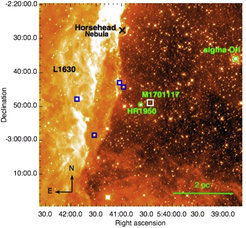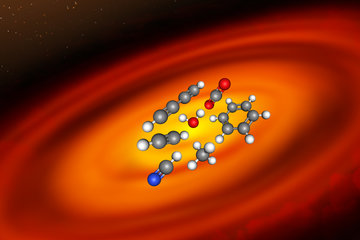Punching above its weight, a brown dwarf launches a parsec-scale jet
Intrinsically faint, brown dwarfs have been more elusive and difficult to study than stars. While not quite massive enough to sustain nuclear fusion at their core – the main energy source for brightly shining stars, they are substantially more massive than giant planets, with about ten times the mass of Jupiter or more. Brown dwarfs are actually quite numerous; there are many more brown dwarfs in our Galaxy than stars like the Sun. Nevertheless, observational information about brown dwarfs in scarce and there is an ongoing debate between astronomers if they form rather like planets or rather like stars do.
![The image shows the jet HH 1165 (in green) launched by the brown dwarf Mayrit 1701117. The image is composed of observations of Hα (from ionised hydrogen), of [SII] (ionised sulfur) and in the R-band (red optical wavelengths) obtained with the SOAR telescope of the Cerro Tololo Inter-American Observatory. The jet extends over a distance of 0.7 light years (equivalent to 0.2 parsecs) northwest of the brown dwarf.](/6875963/original-1517424384.jpg?t=eyJ3aWR0aCI6MjQ2LCJvYmpfaWQiOjY4NzU5NjN9--be227d89624fbf7dcc5d2e5a191e4e1e1d4d2b69)
The image shows the jet HH 1165 (in green) launched by the brown dwarf Mayrit 1701117. The image is composed of observations of Hα (from ionised hydrogen), of [SII] (ionised sulfur) and in the R-band (red optical wavelengths) obtained with the SOAR telescope of the Cerro Tololo Inter-American Observatory. The jet extends over a distance of 0.7 light years (equivalent to 0.2 parsecs) northwest of the brown dwarf.
“We were looking for very young brown dwarfs, and picked this particular object because it showed a wealth of prominent emission lines associated with strong outflow activity from previous ESO VLT spectral observations, which indicated that there is a shock front close to the source,” explains Basmah Riaz, from the Max Planck Institute for Extraterrestrial Physics, who led the study. The image obtained over a total of three nights with the SOAR telescope of the Cerro Tololo Inter-American Observatory shows the newly detected jet, HH 1165, launched by the brown dwarf Mayrit 1701117, which is located in the outer periphery of the 3 million year old sigma Ori cluster. As described by co-author Cesar Briceno from the Cerro Tololo Inter-American Observatory: “We could see surprisingly extended jet emission after the first 30 minutes of integration. It was a real ‘Wow’ moment!”
The jet extends over a distanced of 0.7 light years (equivalent to 0.2 parsecs) northwest of the brown dwarf. The emission knots along the jet reveal that the mass loss is time variable, probably a result of episodic accretion onto the brown dwarf. While outflows have been detected previously from young brown dwarfs, the earlier detections were of "microjets" 10-100 times smaller in extent. “This discovery shows that, like young stars, brown dwarfs can launch powerful parsec-scale jets, and that they build up their mass through an unsteady, episodic process,” explains Basmah Riaz.

The surroundings of the HH 1165 jet is shown in this WISE infrared image. Its host brown dwarf Mayrit 1701117 is located in the outer periphery of the 3 million year old sigma Ori cluster, whose core is marked to the west. The star HR 1950 is located very close to the brown dwarf and several other B-type stars are marked as well, which trace the ionisation front (bright yellow region) to the east of Mayrit 1701117.
“The HH 1165 jet shows all the familiar hallmarks of outflows from stars: emission knots, a cavity with reflection nebulosity, and bow shocks at the ends of the flow. It checks all the boxes quite convincingly,” commented co-author Emma Whelan from the National University of Ireland.
Brown dwarfs are known to be surrounded by disks at birth and to build up their masses by accretion from molecular cloud cores. While it may seem counterintuitive that mass loss (in a jet) is an integral part of how an object grows or gains mass, this situation may arise because of excess angular momentum. When spinning skaters pull in their arms, they spin faster as a result of conservation of angular momentum. Similarly, when large, slowly rotating molecular cloud cores collapse, they may spin up too fast to squeeze down to the much smaller sizes of stars or sub-stellar objects like brown dwarfs.
Riaz speculates that indeed “Molecular cloud cores have much more angular momentum than can be contained by stars or brown dwarfs. So the system needs to lose angular momentum for the object to grow in mass. By removing angular momentum from the system, jets help solve the `angular momentum problem’ faced by stars as well as brown dwarfs.”
To test this hypothesis, the team is on the hunt for more extended jets from brown dwarfs, to understand how commonly they occur. Such jets may be rare due to a lack of the environmental conditions needed to allow the jet to propagate to, and still be visible at, large distances from the source. We would expect that low-luminosity sources are more likely to be found in low-density environments, after disruption and fragmentation of very-low-mass cloud cores. So the problem is more likely to be a lack of dense material to shock against than the difficulty of propagation, which should be easier in a lower density medium.
![The image shows the jet HH 1165 (in green) launched by the brown dwarf Mayrit 1701117. The image is composed of observations of Hα (from ionised hydrogen), of [SII] (ionised sulfur) and in the R-band (red optical wavelengths) obtained with the SOAR telescope of the Cerro Tololo Inter-American Observatory. The jet extends over a distance of 0.7 light years (equivalent to 0.2 parsecs) northwest of the brown dwarf. The image shows the jet HH 1165 (in green) launched by the brown dwarf Mayrit 1701117. The image is composed of observations of Hα (from ionised hydrogen), of [SII] (ionised sulfur) and in the R-band (red optical wavelengths) obtained with the SOAR telescope of the Cerro Tololo Inter-American Observatory. The jet extends over a distance of 0.7 light years (equivalent to 0.2 parsecs) northwest of the brown dwarf.](/6875963/original-1517424384.jpg?t=eyJ3aWR0aCI6MzQxLCJmaWxlX2V4dGVuc2lvbiI6ImpwZyIsIm9ial9pZCI6Njg3NTk2M30%3D--933819d63bc9950907d8f975b642c65605e25f91)












